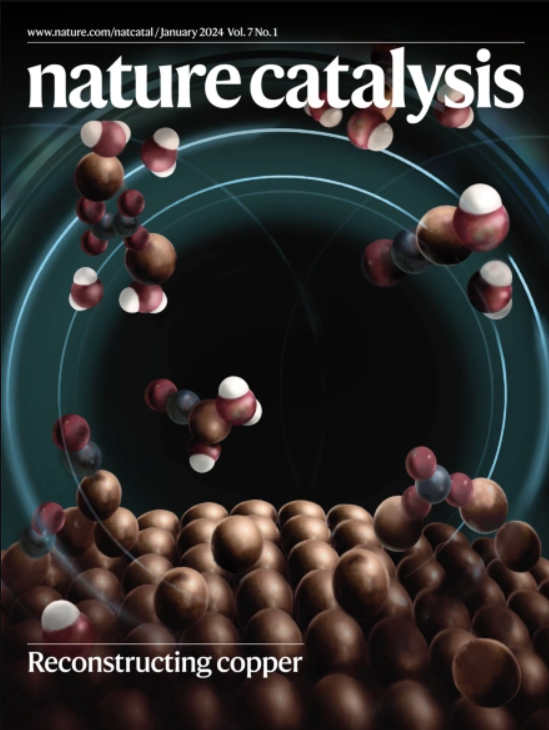Efficient electroreduction of carbonyl compounds to alcohols over Fe/Fe2O3 interfaces
IF 44.6
1区 化学
Q1 CHEMISTRY, PHYSICAL
引用次数: 0
Abstract
Catalytic hydrogenation of carbonyl compounds is widely used in chemical manufacturing and biomass refining, but current thermocatalytic processes require elevated temperatures, high-pressure H2 and expensive catalysts. Here we demonstrate an electroreduction of carbonyl compounds over Fe/Fe2O3 interfaces in Fe/Fe2O3 nanoarrays (Fe/Fe2O3 NAs), where Fe and Fe2O3 species synergistically accelerate the kinetics of acetone hydrogenation by promoting acetone adsorption and H* formation. With acetone as the probe molecule, an isopropanol partial current density of 1.6 A cm−2 and ~100% selectivity are achieved in 1 M KOH aqueous solution. Even in a large-scale, two-electrode electrolyser, Fe/Fe2O3 NAs stably deliver an acetone conversion of >99%, an isopropanol selectivity of 100%, and an isopropanol production rate of 21.6 g gcat−1 h−1 at 0.2 A cm−2 over a 1,000-h operation. Moreover, Fe/Fe2O3 NAs were applied in the electrochemical hydrogenation of various carbonyl compounds to corresponding alcohols with high conversion rates and selectivities. Hydrogenation of carbonyl compounds is used industrially to synthesize alcohols for commodity and fine chemical applications, yet traditional thermocatalytic methods employ elevated temperatures and high pressures of H2. Here high-rate and high-selectivity hydrogenation of acetone to isopropanol over a Fe/Fe2O3 nanoarray electrocatalyst is reported under ambient conditions using water as the hydrogen source.


羰基化合物在Fe/Fe2O3界面上高效电还原为醇
羰基化合物的催化加氢广泛应用于化工制造和生物质精炼,但目前的热催化工艺需要高温、高压H2和昂贵的催化剂。在Fe/Fe2O3纳米阵列(Fe/Fe2O3 NAs)中,羰基化合物在Fe/Fe2O3界面上电还原,其中Fe和Fe2O3物质通过促进丙酮吸附和H*形成协同加速丙酮加氢动力学。以丙酮为探针分子,在1 M KOH水溶液中,异丙醇的偏电流密度为1.6 A cm−2,选择性为~100%。即使在大型双电极电解槽中,Fe/Fe2O3 NAs也能稳定地提供99%的丙酮转化率,100%的异丙醇选择性,以及在0.2 a cm−2下超过1000小时的异丙醇产率为21.6 g gcat−1 h−1。此外,Fe/Fe2O3 NAs应用于各种羰基化合物的电化学加氢反应,具有较高的转化率和选择性。
本文章由计算机程序翻译,如有差异,请以英文原文为准。
求助全文
约1分钟内获得全文
求助全文
来源期刊

Nature Catalysis
Chemical Engineering-Bioengineering
CiteScore
52.10
自引率
1.10%
发文量
140
期刊介绍:
Nature Catalysis serves as a platform for researchers across chemistry and related fields, focusing on homogeneous catalysis, heterogeneous catalysis, and biocatalysts, encompassing both fundamental and applied studies. With a particular emphasis on advancing sustainable industries and processes, the journal provides comprehensive coverage of catalysis research, appealing to scientists, engineers, and researchers in academia and industry.
Maintaining the high standards of the Nature brand, Nature Catalysis boasts a dedicated team of professional editors, rigorous peer-review processes, and swift publication times, ensuring editorial independence and quality. The journal publishes work spanning heterogeneous catalysis, homogeneous catalysis, and biocatalysis, covering areas such as catalytic synthesis, mechanisms, characterization, computational studies, nanoparticle catalysis, electrocatalysis, photocatalysis, environmental catalysis, asymmetric catalysis, and various forms of organocatalysis.
 求助内容:
求助内容: 应助结果提醒方式:
应助结果提醒方式:


